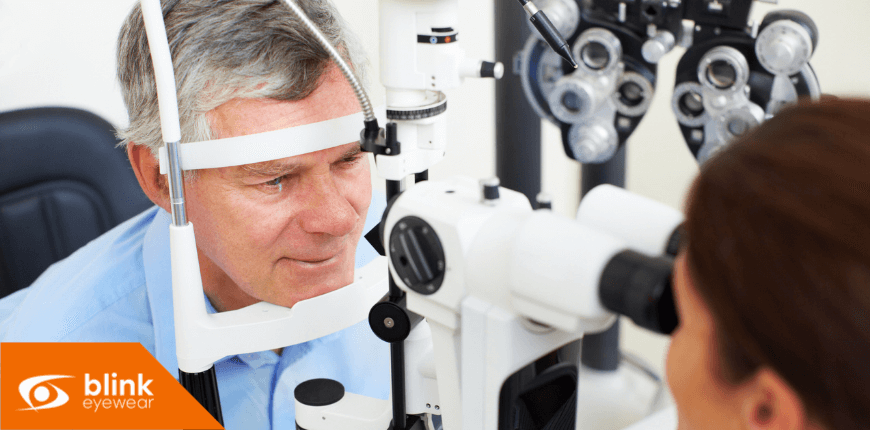
Cataracts are the leading cause of vision loss among the older population. While many live comfortably with mild forms of cataracts, others may have to undergo surgery in order to restore their vision.
The eye doctors at Blink Eyewear provide all the experience necessary to care for or remove your cataracts. In fact, we perform hundreds of cataract surgeries at our Calgary Creekside, West Springs, and Crowfoot locations annually. See the Blink Eyewear difference today.
Cataracts are characterized by cloudiness of the lens of the eye, rendering your vision increasingly blurry and opaque over time. Having your cataracts diagnosed early on is key in managing and treating them. The more advanced your cataracts, the more complicated the surgery. Your optometrist can employ a variety of visual tests to determine the extent of your condition and whether you will need cataract surgery.
How Can I Tell If I Have Cataracts?
A cataract refers to the clouding that gradually takes over the lens of the eye, impairing your vision as it begins to worsen.
The symptoms of a cataract may be undetected at first. The appearance of a cataract might cause a decrease of sight in one eye. This may go unnoticed as your other eye will attempt to compensate for the vision loss. You may even experience a temporary improvement in your near vision一colloquially known as the “second sight.”
As the cataract develops, you may experience the following symptoms:
- Blurred vision
- Light sensitivity
- Impaired night vision
- Fading of colour vision
- Double vision
- Faulty depth perception
If allowed to progress untreated, cataracts may lead to complete blindness.
Diagnosing Cataracts
The comprehensive eye exam comprises multiple visual tests that can help your optometrist learn more about your cataracts:
Visual acuity test: By having you read letters of different sizes from a chart, your optometrist assesses the quality of your vision at various distances. Visual acuity tests are a simple and effective way to diagnose imperfect vision一a symptom of cataracts, but they cannot ascertain the presence of cataracts by themselves.
Contrast sensitivity test: This test measures your ability to distinguish small changes in contrast. Struggling to recognize contrast could be a sign of cataracts.
Slit lamp test: The slit lamp refers to the large microscope with the chin rest found at every optometry office. The instrument allows your optometrist to directly see the cataract in your eye and the degree to which it is clouded.
Pupil dilation test: Your optometrist applies drops into your eye, dilating the pupil. With your pupil enlarged, your optometrist gets a clear view of your cataract.
Potential acuity test: This test estimates how good your eyesight could be if you did not have cataracts. A laser projects acuity charts directly into the eye, allowing the patient to perform a standard visual acuity test without interference from the cataract. This experiment can play an important role in deciding whether cataract surgery is worthwhile for the patient.
Treating Cataracts
Once your optometrist has determined the severity of your cataract, they can begin formulating a treatment plan to combat it.
First, note that not all cataracts are guaranteed to worsen over time. Some stop progressing after a certain point. Therefore, if your cataract is mild to moderate and has stabilized, you will probably not need any surgery. Corrective eyeglasses, artificial tears, tinted lenses can all minimize the symptoms associated with cataracts.
Second, cataracts do not go away on their own and can only be removed via surgery. Although considered low-risk, cataract surgeries are only reserved for the most severe cases一those that may lead to blindness.
Cataract surgery involves removing the clouded lens altogether and replacing it with an artificial lens implant. If performed successfully, the patient can resume their life as normal and will not experience any significant medical side effects.
Cataract Treatments For You Today
Cataracts are one of the most common eye conditions among older people, but their prevalence does not make them any less dangerous. If you suspect you have cataracts, have an assessment with your optometrist as soon as possible. Your eye doctor will let you know how best to deal with your cataracts, whether it be careful management or surgery.
Performing hundreds of successful cataract surgeries every year, our Blink Eyewear eye doctors are at the forefront of cataract management and treatment. Call us at 403-516-2292 or fill out the online contact form to begin your cataract care with us.
FAQ
Q: What causes cataracts?
A: The chances of contracting cataracts naturally increase with age. Other risk factors include:
- Diabetes
- Eye surgery
- Family history
- Smoking
- Certain medications
- UV exposure
- Radiation
- Eye trauma
Q: Can I prevent cataracts from developing?
A: There is no specific thing one can do to prevent cataracts. Controlling your diabetes, avoiding smoking, and keeping your eyes away from harmful UV rays can reduce your chances of contracting cataracts.
Q: Are surgeries for cataracts safe?
A: Yes. Cataract surgery is considered low-risk. According to a survey conducted from 1994 to 2006, 99.5% of patients reported no severe complications following their surgery.